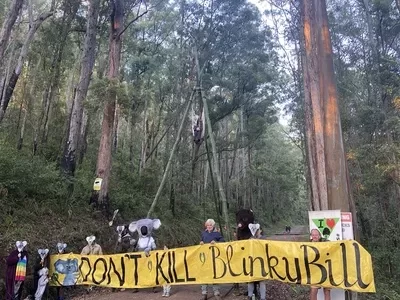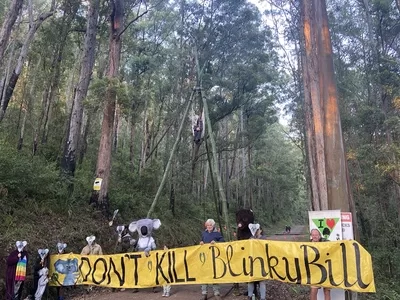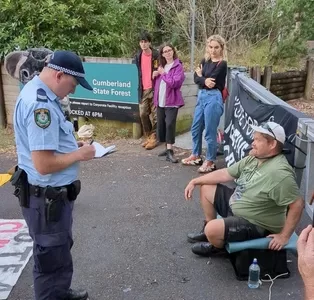These two academic articles accompany our feature on the issue of logging native forests for wood-fired electricity. Discussed here is the Great Koala National Park, Regional Forest Agreements (RFAs), Threatened Species Expert Panel, and the problems faced by governments:
NSW logging laws value timber over environmental protection
New South Wales is revamping its logging laws for the first time in two decades, drafting regulations that will govern more than two million hectares of public native forest.
Among the changes are proposals to permit logging in exclusion zones – part of the reserve system – and dramatic increases to the scale and intensity of logging, putting several threatened species at direct risk.
NSW can implement these changes unilaterally. But if it does, NSW will effectively be asking the federal government to agree to changes that directly contradict the federal Threatened Species Strategy and several species recovery plans, and reduce the extent of the reserve system.
Regional Forest Agreements
The federal government has arrangements with the states called Regional Forest Agreements (RFAs).
They provide certainty to logging operations by accrediting state logging rules under federal environment law. No other industry gets this treatment – but RFAs are now expiring after having been in place for 20 years.
But the proposed changes to NSW logging laws clearly prioritise timber extraction over environmental protection.
In 2014 the NSW government extended wood supply agreements with timber companies, locking in a commitment to logging at a certain level. The changes are cited as necessary to meet these wood supply agreements.
This means abandoning commitments made under the National Forest Policy Statement in 1992, including the concept of ecologically sustainable forest management.
This is a fundamental shift and, because of the impacts on the reserve system and threatened species, against the national interest.
Overlogging is behind the changes
In its 2016 Forestry Industry Roadmap the NSW government made a dual commitment to maintain logging levels without eroding environmental protection.
However, the NSW Natural Resources Commission tasked with finding a way to do this reported “it is not possible to meet the government’s commitments around both environmental values and wood supply”.
The commission therefore recommended the NSW government “remap and rezone” old-growth forest and rainforest to increase the area that can be logged and make up timber shortfalls.
There are three kinds of zones that make up protected forest reserves. The first zone requires an act of state parliament to revoke, but the second and third can be revoked by the state forestry minister.
To further increase timber supply, headwater stream buffers – areas around waterways that cannot be logged – will be reduced from 10 metres to five.
The new laws also permit the logging of giant trees up to 140cm in diameter, or 160cm in the case of blackbutt and alpine ash (preferred timber species).
Northeast NSW to see the biggest changes
In northeast NSW, a new “intensive harvesting zone” will cover 140,000 hectares of coastal forests between Taree and Grafton.
These forests are in the Forests of East Australia global biodiversity hotspot and many are included in a proposed Great Koala National Park.
This will see 45-hectare patches of forest cleared of all but a smattering of small trees.
The intensity of logging everywhere else in the “selective” harvesting zone will, on average, double.
Implications for wildlife and forest ecosystems
The new proposals move towards a retention model where habitat features are to be retained in clumps over several logging cycles.
This “retention approach” is good in theory, but is undermined by the landscape-wide intensification of logging – particularly in the intensive zone – and the need to maximise timber production, not the conservation of forest species.
Although hollow-bearing trees are to be retained, no younger trees – which will eventually replace their elders – are required to be protected.
This means the inevitable loss of hollow-bearing trees, exacerbated by logging rezoned old-growth. There is no longer any requirement to protect eucalypt nectar trees, vital resources for the critically endangered regent honeyeater and swift parrot.
A report on the proposals from the Threatened Species Expert Panel reveals that almost no data was available to design the new environmental protections, and there was great uncertainty as to whether they will work. One panel member commented:
The intensive harvesting zones are being formally introduced to prop up an unsustainable wood supply arrangement at the expense of the environment.
It is frustrating trying to be part of the solution when the underlying driver of the wood supply agreements fundamentally restricts any chance of a balanced approach.
The federal government has a problem
The federal government has already committed to extending Regional Forest Agreements with the states. Yet besides potentially reducing the size of the reserve network, NSW’s proposals directly threaten federally-listed species.
Conservation advice for the marsupial greater glider clearly states the impact of habitat loss and fragmentation through intensive logging.
Koalas prefer large trees and mature forests, yet the intensive logging zone will cover almost half of identified high quality koala habitat.
Legally, loggers will only have to keep 10 trees of 20cm diameter per hectare – far too few and too small for koalas.
The national recovery plan for the swift parrot proposes the retention of all trees over 60cm diameter – clearly incompatible with the proposed intensive harvesting zone – while the recovery plan for the regent honeyeater identifies all breeding and foraging habitat as critical to survival.
Recent research has predicted a 31% probability of swift parrot extinction in the next 20 years, and a 57% probability for the regent honeyeater. Both birds are priority species under the Australian government’s Threatened Species Strategy.
Public feedback on the proposed changes is invited until June 29. After that, the federal government must decide whether it deems the proposals to be consistent with national environment law in a new Regional Forest Agreement.
Signing off on these changes will cast serious doubt on the federal government’s commitment to the national environmental interest.
Author: Oisín Sweeney, Senior Ecologist at the National Parks Association of NSW, Research Fellow, University of Sydney
Published: June 19, 2018. This article is republished from The Conversation under a Creative Commons license. Read the original article.
°°°
Native forest protections are deeply flawed, yet may be in place for another 20 years
State governments are poised to renew some of the 20-year-old Regional Forest Agreements (RFAs) without reviewing any evidence gathered in the last two decades.
The agreements were first signed between the federal government and the states in the late 1990s in an attempt to balance the needs of the native forest logging industry with conservation and forest biodiversity.
It’s time to renew the agreements for another 20 years. Some, such as Tasmania’s, have just been renewed and others are about to be rolled over without substantial reassessment.
Yet much of the data on which the RFAs are based are hopelessly out of date.
Concerns about the validity of the science behind the agreements is shared by some state politicians, with The Guardian reporting the NSW Labor opposition environment spokeswoman as saying “the science underpinning the RFAs is out of date and incomplete”.
New, thorough assessments are needed
What is clearly needed are new, thorough and independent regional assessments that quantify the full range of values of native forests.
Much of the information underpinning these agreements comes largely from the mid-1990s.
This was before key issues with climate change began to emerge and the value of carbon storage in native forests was identified; before massive wildfires damaged hundreds of thousands of hectares of forest in eastern Australia; and before the recognition that in some forest types logging operations elevate the risks of crown-scorching wildfires.
The agreements predate the massive droughts and changing climate that have affected the rainfall patterns and water supply systems of southwestern and southeastern Australia, including the forested catchments of Melbourne.
It’s also arguable whether the current Regional Forest Agreements accommodate some of the critical values of native forests. This is because their primary objective is pulp and timber production.
Yet it is increasingly apparent that other economic and social values of native forests are greater than pulp and wood.
To take Victoria as an example, a hectare of intact mountain ash forests produces 12 million litres more water per year than the same amount of logged forest.
The economic value of that water far outstrips the value of the timber: almost all of Melbourne’s water come from these forests. Recent analysis indicates that already more than 60% of the forest in some of Melbourne’s most important catchments has been logged.
The current water supply problems in Cape Town in South Africa are a stark illustration of what can happen when natural assets and environmental infrastructure are not managed appropriately.
In the case of the Victorian ash forests, some pundits would argue that the state’s desalination plant can offset the loss of catchment water. But desalination is hugely expensive to taxpayers and generates large amounts of greenhouse emissions.
A declining resource
Another critical issue with the existing agreements is the availability of loggable forest. Past over-harvesting means that much of the loggable forest has already been cut.
Remaining sawlog resources are rapidly declining. It would be absurd to sign a 20-year RFA when the amount of sawlog resource remaining is less than 10 years.
This is partially because estimates of sustained yield in the original agreements did not take into account inevitable wood losses in wildfires – akin to a long-distance trucking company operating without accident insurance.
Some are arguing that the solution now is to cut even more timber in water catchments, but this would further compromise water yields at a major cost to the economy and to human populations.
Comprehensive regional assessments must re-examine wood supplies and make significant reductions in pulp and timber yields accordingly.
The inevitable conclusion is that the Regional Forest Agreements and their underlying Comprehensive Regional Assessments are badly out of date.
We should not renew them without taking into consideration decades of new information on the value of native forests and on threats to their preservation.
Australia’s native forests are among the nation’s most important natural assets. The Australian public has a right to expect that the most up-to-date information will be used to manage these irreplaceable assets.
Author: Professor David Lindenmayer, The Fenner School of Environment and Society, Australian National University.
David Lindenmayer receives funding from the Australian Research Council, the Australian Government and the Victorian Government.
Published: March 23, 2018. This article is republished from The Conversation under a Creative Commons license. Read the original article.
![]()
![]()








